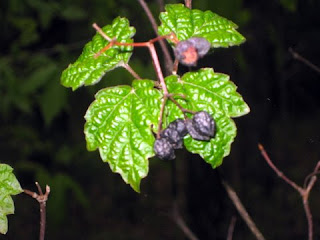
Last evening we took our first "Monday Evening" Discovery walk. We say a lot of interesting things, some well known, some less so...
Just as we started out I noticed small yellow flowers mixed in with the grass. I laid down to see (I said they were small!), we dug out Newcomb's Wildflower Guide and... we had found Dwarf Cinquefoil http://plants.usda.gov/java/profile?symbol=POCA17 (Photo: Thomas G. Barnes @ USDA-NRCS PLANTS Database / Barnes, T.G., and S.W. Francis. 2004. Wildflowers and ferns of Kentucky. University Press of Kentucky.)
We also saw a plant with leaves shaped like maple leaves, but it wasn't a Maple tree. Jerry thought it was "Maple-Leaved Viburnam", and checking our guidebooks showed he was right. (Photo: Joe Keogh - of another, taken on RLBH hike.)

In the swamppy area right next to Blue Hill River Road and Hillside St. there was a great load of skunk cabbage flourishing. Skunk Cabbage http://plants.usda.gov/java/profile?symbol=LYAM3
We also saw both High Bush Blueberry http://plants.usda.gov/java/profile?symbol=VACO and Low Bush Blueberry http://plants.usda.gov/java/nameSearch Based on what we saw, it looks like it may be a good year for bluwberries :-)
We also spent some time discussing and comparing birch trees, and a beech tree.
Birch: http://plants.usda.gov/java/profile?symbol=BETUL
Paper Birch http://plants.usda.gov/java/profile?symbol=BEPAP
Gray Birch http://plants.usda.gov/java/profile?symbol=BEPO
American Beech http://plants.usda.gov/java/profile?symbol=FAGR
Life is easy when you can just say "Birch" and move on.. but becomes more interesting when you open the guide books and look at all the possible varieties of birch trees. My opinion is Gray Birch. While we might not score a perfect 100 on the ID test, we do have fun trying :-)
We also saw Pepperbush http://plants.usda.gov/plantguide/pdf/pg_clal3.pdf, although ours was not yet in bloom.
Note: Most of the above links and photos are from http://plants.usda.gov/ Check it out. It has information on many of the plants we see, and provides lots of good information. (Ref: USDA, NRCS. 2009. The PLANTS Database (http://plants.usda.gov, 5 May 2009). National Plant Data Center, Baton Rouge, LA 70874-4490 USA.)